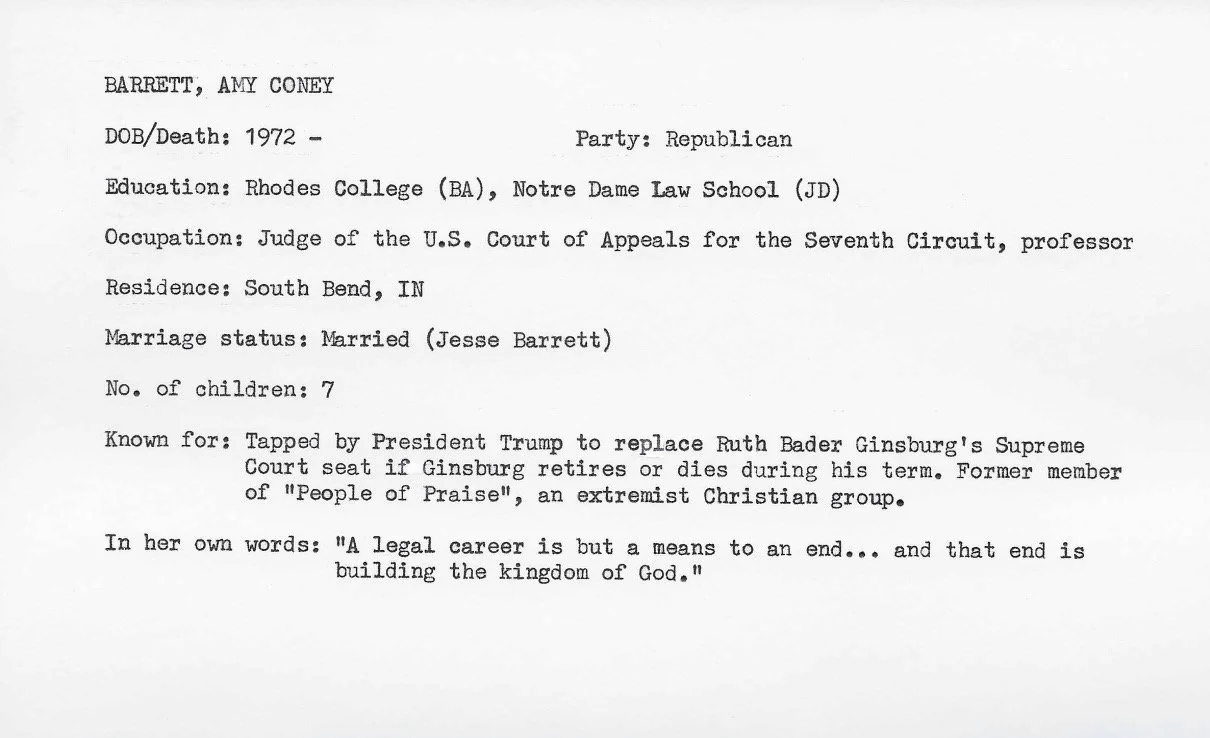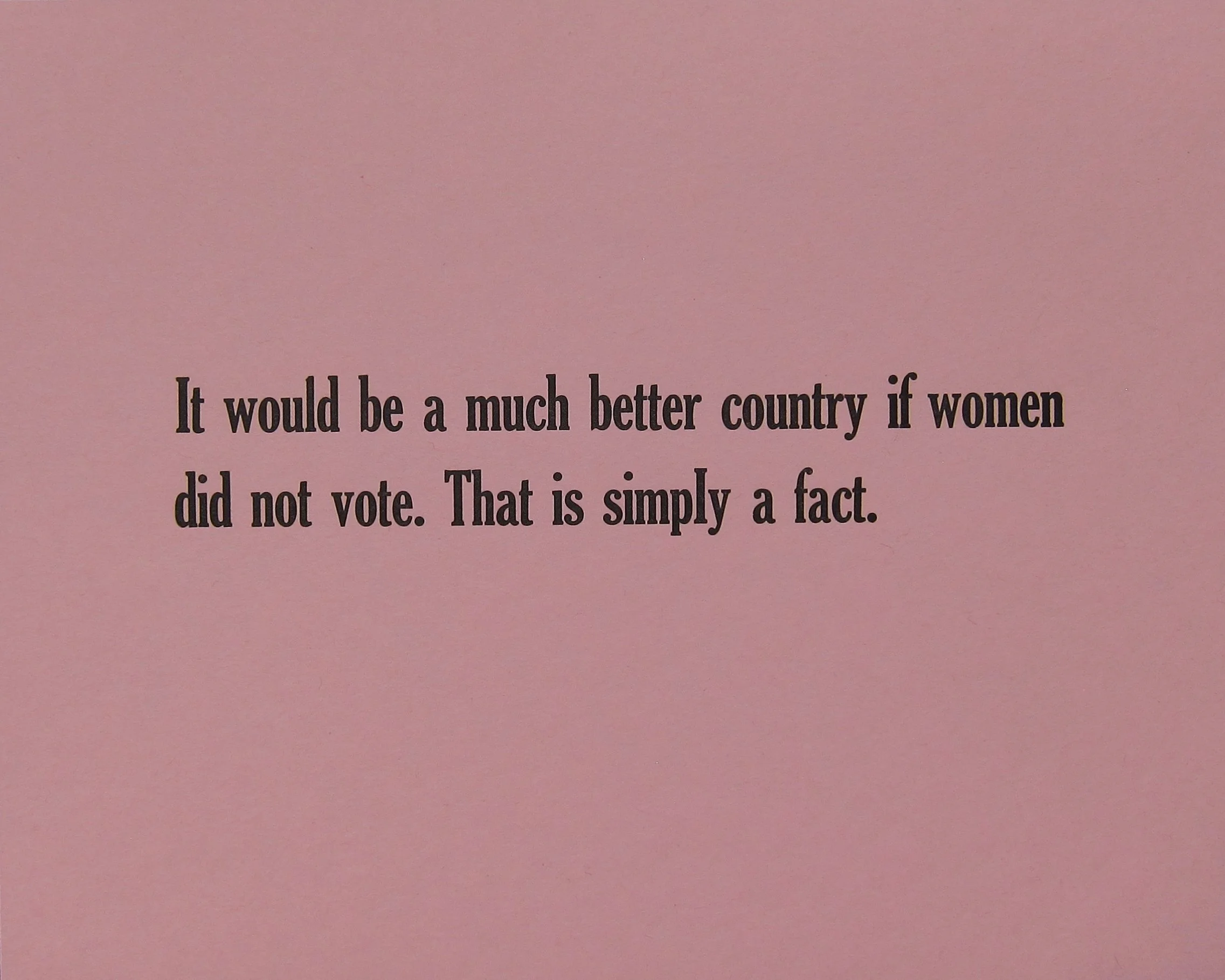Are Women Upholding the Patriarchy?
Inside Michelle Vaughan’s Portraits of Anti-Feminist Power
From Unity to Division
The 1920s in the US were pivotal for women’s rights (or at least those who were white and wealthy*). Women fought for the right to vote, political and economic equality, personal autonomy and equal access to education and opportunities. They united against inequality, sexism and bigotry, forces that had long stifled women’s advancement and directly threatened their wellbeing.
Yet, after the 1920s, something had shifted in the ideology of the united voice of women. One side saw the 19th Amendment, giving all U.S. citizens the right to vote, as a mere beginning of rights and freedoms for the entire womanhood. The other side of this movement started producing highly educated, independent and strong women who saw the 19th Amendment as sufficient, still believing in the traditional hierarchies and the roles of man and woman within the family and society, yet enjoying certain freedoms like the right to education and vote. Though born from the same movement, these two camps diverged sharply. One pushed for full emancipation from gender roles and the other fought to protect what it saw as core American values - family, tradition, and liberty.
Did the movement splinter, or was this contradiction always there - like two sides of one coin?
Michelle Vaughan’s Archive of Anti-Feminist Resistance
Michelle Vaughan’s solo exhibition, A Movement of Women, became our entry point into that question. We tried to understand the history and challenges of the feminist movement, interested in dissecting the pivotal moments for women in modern history.
In A Movement of Women, Michelle decided to investigate 40 conservative women who, between 1920 and 2020, have been instrumental in preserving the family values (aka patriarchy) whilst holding positions of power - looking at their contributions, education, accomplishments, and modes of building their audience.
Who are they? Coming from the top of societal structures, politicians, entertainers, activists, judges and writers, helping shape this movement in the 20th and 21st centuries. Each profile has a “file”, including a beautifully crafted pastel portrait, and an accompanying data index box with metadata and details. “Like a little CV about each person, you get their date of birth, timeline, education, place of origin, marital status and whether they have children. My real interest was: If this person was educated, where did they go to school? How many degrees do they have? That was really interesting,” says Michelle, who put incredible effort into bringing the biographies of those women to life.
There was also one more thing - a quote summing up their perspective or philosophy of womanhood and the role women should play in society.
But Michelle didn’t stop at portraits. To create a full ecosystem of ideology, she gathered a library of either biographies or books authored by the subjects of this exhibition. There was also memorabilia from the Cold War - propaganda songs, pamphlets, buttons, stickers, magazine articles, all collected to better understand the active role conservative women played and continue to do so in politics. Michelle’s goal was to depict the world through their eyes, creating a middle ground space of tension, where discomfort could prompt reflection rather than defence. Here, the spectators were able to see a movement of women from a different perspective.
Michelle’s goal was to create a space of tension where discomfort could prompt reflection and lessons without jumping into defence. Whether the attendees were conservative women or progressive visitors, the main goal was for them to learn. This project wasn’t created to tell the audience what to think; instead invited them to sit with the discomfort. And it really did - some visitors reported becoming deeply affected by the lingering tension.
The Women of Trump’s America
When asked about some of the most memorable women portrayed in the Movement of Women, we learned about Nikki Haley. Haley, a Republican, is the first Indian American to serve in a presidential cabinet. Haley’s achievements are awe-inspiring, but in 2012, she said something we found chilling in light of the recent rollback of Roe versus Wade. Her famous quote, “There is no war on women”, has been immortalised on one of the quote-cards and is there to remind us that in the last 10 years, the ability for women in the United States to get an abortion has been limited by about a third. This is not a coincidence - the gap between rhetoric and reality is in a crisis.
Another person worth mentioning is Amy Coney Barrett. Barrett is a high overachiever, the smartest in her class, graduated with honours in all of her degrees, and has been given copious awards throughout her entire career. As a law professor at Notre Dame, she was even twice voted “Distinguished Professor of the Year” by the students. She has always been going for maximum success, and now - she’s one of the most important and powerful conservative women in the US. Now, let’s switch to another side of her all-successful story. Amy grew up a part of a smaller religious sect called the People of Praise. To depict the general ideology of this group, the highest office a woman can hold in the community is “woman leader”, until 2017 called a “handmaid”. Reading the group’s controversial views, many say that it poses characteristics of psychological and social control and refers to People of Praise as a cult.
Barrett comes from a family of seven, and she has seven children, including two adopted kids. “I have a lot of respect for her accomplishments”, says Michelle, but despite her successful career as a skilful law practitioner and teacher, Barrett’s now infamous quote says, “A legal career is but a means to an end, and that end is building the Kingdom of God”. What happens when a religious mission becomes legal doctrine?
It’s a paradox - highly successful women with respected histories, playing the most powerful roles in the MAGA Trump universe.
The Religion Question
What we learned from this project was that around 95% of the profiled women are highly religious. “Having religion as a guide whilst taking a higher education track is commendable - it’s a force in your life. But if that religion supports a patriarchal system, what happens to your guide?” - wonders Michelle.
Many women profiled in this project hold higher education degrees. One example includes Mildred Fay Jefferson, the first African American woman to graduate from Harvard Medical School. Despite her achievements, she remained a firm right-to-life activist, famously turning Ronald Reagan to switch from being pro-choice to pro-life.
Here lies another paradox: women who once fought for their own education and freedom now work to deny those same rights to others. Across the project, religion emerges not only as personal belief but as political infrastructure.
Ann Hart Coulter, born December 8, 1961, is an American conservative media pundit, author, syndicated columnist, and lawyer. She became known as a media pundit in the late 1990s, appearing in print and on cable news as an outspoken critic of the Clinton administration.
Trump 2.0 - A Movement of Women continues
Our conversation with Michelle moved to a movement of women post-2021, exploring the reality of Trump 2.0, the women around him and the status of women’s rights. According to Michelle, Trump is a loyalist and wants everyone to step in line, even more so in his second term. He has, yet again, found powerful, well-educated women like Karoline Leavitt or Marjorie Taylor Greene who believe in his cause and brought them into his administration.
But, Michelle said, something did change since 2016, and that’s the Me Too movement. Me Too exposed the grey area of protecting criminals and victim-blaming. “Businesses, schools and institutions had to become very mindful of how women are treated - they face more pressure to apply new layers of protection, all because of Me Too.” What once passed as harmless is now scrutinised and hopefully will become increasingly widespread across the world.
“We are at an inflexion point” - The Paradox of Progress
Asked what parts of early feminist thought we should preserve, Michelle talked about the very basic idea of equality between men and women. And despite the regression, Michelle holds onto a basic truth: equality is non-negotiable.
One of the ways to bring back the conversation about the equality of men and women is to invite younger voices, those who become an easy target for the right-wing ideology preachers. Have we failed to pass down our urgency to fight?
For Michelle, now in her 50s, Gloria Steinem plays a big role in paving a path for her generation. We might have lost the stories passed from our elders who struggled to achieve the freedoms we today take for granted. Hearing horror stories from our mothers and grandmothers living through major cultural shifts of the 19th and 20th centuries should help us understand what we are really fighting for.
To preserve the idea of feminism, Michelle believes in the power of education. We are at an inflexion point, and it’s about time we open the doors and move forward together.
Epilogue
Just like the Movement of Women, we need to keep remembering those who fought for our freedoms, but also studying those who made other life choices and study opposing perspectives. Michelle’s project will live on, enriched, perhaps, with new profiles and metadata, reminding us why bringing young people into the conversation is the best thing we can do together in order to press forward in our rights and freedoms.
Michelle Vaughan
Visual artist, author of Generations I, II, III, Davos Drawings, A Movement of Women
I grew up surrounded by my grandfather’s modernist paintings. Once my parents realized I was fixated on art they brought me to museums in Los Angeles, an hour north of where we lived. When I was 18, I spent 3 years in a traditional program until moving to a conceptual one at UCLA. I made much less art than I read theory there, but that education shaped my approach and I was lucky to study under many accomplished artists. After graduating, I moved to New York and took more technical art classes and still continue to learn new techniques when necessary.
I am a project-based artist primarily producing drawings and prints, but will expand into various mediums. My topics include history, art history, politics and social issues. I live with my husband, Felix Salmon, in Chinatown, NYC.
https://www.michellevaughan.net - Visit Michelle Vaughan’s website to learn about her work and life
https://www.instagram.com/black_von - Follow Michelle on IG







